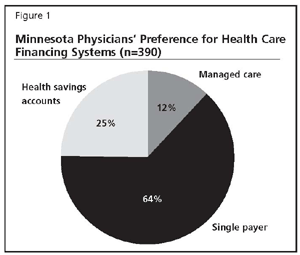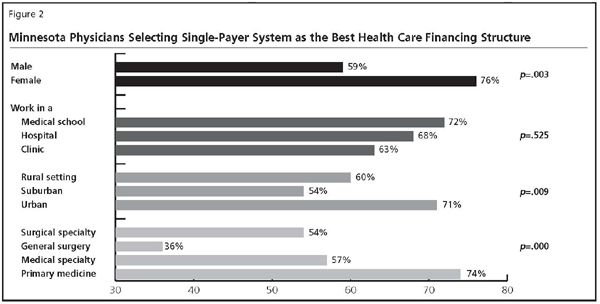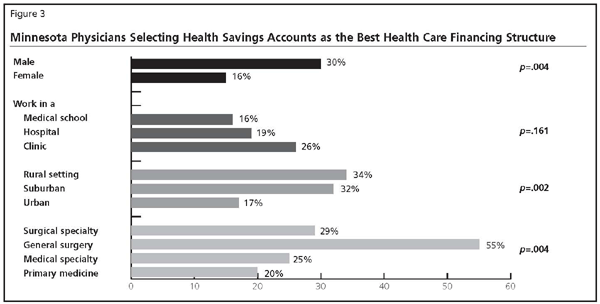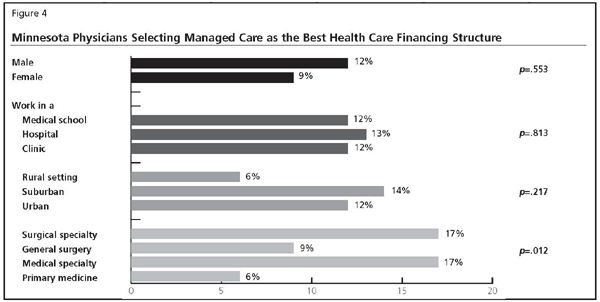Single-Payer, Health Savings Accounts, or Managed Care?
Minnesota Physicians’ Perspectives
CLINICAL & HEALTH AFFAIRS
Minnesota Medicine
February 2007, Volume 90
Published monthly by the Minnesota Medical Association
By By Joel M. Albers, Pharm.D., Ph.D., Breanna Peterson Lathrop, Kirk C. Allison, Ph.D., Charles N. Oberg, M.D., and James F. Hart, M.D.
Abstract
The United States is facing a health care crisis with the number of uninsured Americans exceeding 46 million and health care premiums and overall costs increasing at 3 to 4 times the rate of inflation. Proposed solutions include continuing managed care, moving to a single-payer financing system with universal coverage, and replacing traditional health plans with high-deductible policies that allow patients to draw from health savings accounts (HSAs) to pay out-of-pocket costs. Despite physicians’ vital role in health care, few studies have assessed their preferences regarding health care financing systems. We surveyed a random sample of licensed Minnesota physicians to determine their preferences regarding health care financing systems. Of 390 physicians, 64% favored a single-payer system, 25% HSAs, and 12% managed care. The majority of physicians (86%) also agreed that it is the responsibility of society, through the government, to ensure that everyone has access to good medical care. Less than half (41%) said that the private insurance industry should continue to play a major role in financing health care. The accumulating knowledge about physicians’ preferences for various health care financing mechanisms merits widespread inclusion in policy debates.
In 2001, the Institute of Medicine reported that the U.S. health care system is failing both clinicians and patients, that their frustration levels have never been higher, and that fundamental changes are needed.1 By 2005, more than 46 million Americans, including 400,000 Minnesotans, were uninsured, and health insurance premiums and overall costs were rising at a rate 3 to 4 times that of general inflation and wages.2-4 Employers have been forced to eliminate or cut back on health benefits, often increasing employee out-of-pocket costs beyond many households’ ability to pay. In 2004, the average Minnesota household spent $11,000 on health insurance premiums and out-of-pocket costs; that figure is projected to reach $22,000 by 2010 if current trends continue.4
For those reasons, the consensus among most observers is that urgent reform is needed. Proposed solutions to the health care financing crisis include continuing with the current managed care system, moving to a single-payer system, or moving toward one in which individuals rely on high-deductible health plans with health savings accounts (HSAs). Minnesota has one of the most established managed care systems in the United States, with 4 managed care companies insuring or handling administrative duties associated with insuring more than 90 percent of Minnesotans who have health coverage. These organizations often group physicians into price-tiered, competitive networks. Recent physician surveys document significant concerns about managed care including concern about ethical issues, physician satisfaction, effects on the physician/patient relationship and on the profession itself, quality of care, and cost-effectiveness.5-10
A Medline search produced 4 randomized studies published between 1993 and 2005 that examined physicians’ health care financing preferences. They indicate growing support for a single-payer model that is publicly financed and administered by a single, public payer.11-14 Such systems lower costs through economies and efficiencies of scale and streamlined administration yet still allow physicians to work in private practices and preserve quality care. State and national studies comparing financing models increasingly suggest the potential for a single-payer system to achieve universal, comprehensive coverage without increasing total health care spending.15-17
Health savings accounts, enacted by the 2003 Medicare Part D drug law, are tax-free savings accounts to which individuals and employers contribute. The money can be drawn out to pay for approved medical expenses. Individuals and families with high-deductible health insurance plans are eligible to open HSAs. Proponents of HSAs argue that patients with health insurance policies that require little or no deductible or co-pay perceive health care as being “free” and become insensitive to price. The belief is that these individuals overuse health care and drive up costs. The idea behind what is being called “consumer-directed health care” is that having a high-deductible health plan with an HSA forces consumers to spend their own money, prompting them to cut back on frivolous health care usage. This type of financing system is also designed to encourage physicians and hospitals to compete on price, theoretically lowering costs. Despite health care over-utilization by consumers being greatly overstated and the lack of evidence that consumer-directed health care actually lowers costs or improves quality, high-deductible plans with HSAs have been heavily marketed across the United States and in Minnesota.18,19
To date, no one has compared Minnesota physicians’ attitudes toward single-payer, consumer-directed, and managed care systems. Thus, we developed and conducted a survey to probe which financing system physicians believe will provide the best care to the most people for a given amount of money.
Methodology
Study Sample and Data Collection
Following approval by the University of Minnesota’s Institutional Review Board, a list of all 17,766 physicians licensed in Minnesota was obtained from the Minnesota Board of Medical Practice; the number was reduced to 13,770 after eliminating those with out-of-state addresses. A random sample of 1,061 physicians was then generated using M initab Statistical Software. Surveys accompanied by a cover letter inviting participation and a consent form were mailed on December 6, 2005. Twenty-seven were returned undeliverable and randomly replaced. Physicians could fill out a paper survey or complete an online version. Those who did not respond were sent a second mailing in January of 2006. Altogether, 408 physicians responded by the February 13, 2006, cut-off. Those respondents closely approximate population parameters by sex (within 0.6%), by rural/metropolitan practice (within 1.3%), and across 4 practice categories (within 0.4% to 2.6%). Those categories were primary medicine (internal medicine and family medicine, pediatrics, general practice, and geriatrics), all other medical specialties, general surgery, and surgical specialty (anesthesiology, orthopedics, obstetrics, gynecology, pediatric surgery, and neurosurgery).
Survey Design
We updated an 11-item survey by McCormick et al. and expanded it to 16 questions in order to reflect current trends and maintain state-to-state comparability.11 Questions assessed physicians’ opinions about various health care financing structures (single payer, HSAs, and managed care) and gathered information about participants’ demographics, primary specialty, and geographic and primary practice settings.
To elicit physicians’ preferences regarding health care financing structures, we asked, “Which of the following 3 structures would offer the best health care to the greatest number of people for a given amount of money?” Respondents could select “current competitive multi-payer managed care systems,” “single payer with universal coverage,” or “individualized insurance coverage utilizing health savings accounts” as answers.
We defined those financing mechanisms as follows:
Multi-payer managed care. The current market-based system in which individuals are enrolled in 1 of a variety of private insurance plans. Plans offer certain health care benefits and use utilization review to control costs and improve quality.
Single-payer system. A single insurance plan administered by a governmental body or publicly accountable commission, guaranteeing coverage and access to necessary medical treatment. Under such a system, hospitals would remain privately owned and physicians would be employed by private groups and practices.
Individualized coverage utilizing health savings accounts. Individuals with high-deductible health insurance plans can use pretax money from a health savings account to pay for current and future health expenses.
Statistical Analysis
We performed chi-square analysis to identify the demographic variables significantly associated with physician financing system preference (2-tailed, alpha .05) including sex, geographic location, primary specialty, and primary practice setting.
To determine the influence of nonresponse bias, we performed a sensitivity analysis recalculating response proportions for managed care, single-payer, and HSA preference relative to Minnesota physician population parameters for specialty, sex, and geography (rural versus metropolitan).
Using binary logistic regression models, we assessed the relationship between preferred system and chi-square significant variables (including general attitude, working environment, rural or urban setting, sex, salary system, and other demographic variables). The Likert scale responses “strongly agree” and “somewhat agree” were combined as were “strongly disagree” and “somewhat disagree.”
Statistical analysis was performed using Minitab Statistical Software (Release 14) (chi-square, logistic regression) and Microsoft Excel 2000 (sensitivity analysis, binomials).
Findings
A majority of respondents (72%) were male with a median medical school graduation year of 1979. Nearly half (46%) practiced primary medicine, followed by medical specialty (35%), surgical specialty (12%), and general surgery (6%). More than three-quarters (79%) worked in a metropolitan setting, and nearly two-thirds (65%) practiced in a clinic.
Of the 390 respondents who answered the question about which financing system would offer the best health care to the greatest number of people for a fixed amount of money, 64% said they favor a single-payer financing system, 25% preferred HSAs, and only 12% preferred managed care (Figure 1). Figures 2 through 4 offer a closer look at who prefers those financing structures by sex, geographic location, specialty, and type of practice.


A single-payer system was favored by women physicians over men (female, 76%; male, 59%; p=.003); more male physicians than female preferred HSAs (male, 30%; female, 16%; p=.004). The percentage of male respondents who favored the current managed care system slightly exceeded that of female physicians (12% versus 9%; p=.553).
Geographic setting was also significantly associated across the 3 choices. Urban physicians favored a single-payer system over their rural and suburban colleagues (71%, 60%, and 54%, respectively; p=.009). Rural physicians preferred HSAs over suburban and urban physicians (34%, 32%, 17%; p=.002). Managed care garnered less than 15% support overall, with 14% of suburban physicians, 12% of urban doctors, and 6% of rural respondents favoring it; p=.217). Thus, urban physicians had the most support for a single-payer system and the least for managed care. Rural physicians were relatively enthusiastic for HSAs but least supportive of managed care.


When looking at physicians’ responses across medical specialty, those practicing primary medicine most favored a single-payer system (74%); general surgeons least favored such a system (36%). Conversely, general surgeons most favored HSAs (55%), and primary medicine physicians least favored them (20%). Managed care found greatest support among physicians who practiced a medical or surgical specialty (17% each) and the least among those who practiced primary medicine (6%). Of those who favored managed care, the significant split was specialists over generalists (17% and 7%; p=.001).
Physicians also were asked who should be responsible for providing access to health care. Nearly all (86%) believed it is the responsibility of society through government to ensure access to good medical care for all, regardless of ability to pay. Only 41% held that the private insurance industry should continue to play a major role in medical care financing and delivery.
Using a regression model, we found that physicians who agreed that it is the government’s responsibility to ensure access to medical care were significantly more likely to favor a single-payer financing system (OR 13.51; CI 2.85, 64.15; p=.001). Those who believed the private insurance industry should continue to play a major role in financing medical care were significantly less likely to favor a government-run system (OR 3.45; CI 1.35, 8.33; p=.009).
Corroborating Results
In order to corroborate our results about physicians’ preferences for various financing systems, we asked separate questions about their opinions of each of the 3 structures. We found 56% held a generally favorable view of single-payer systems, 46% of HSAs, and 20% of managed care systems in which physician groups compete for placement in cost-tiered networks. (The total exceeds 100% as some physicians were generally favorable toward more than
1 system.)
Thus, more respondents said they preferred a single-payer system than held a favorable view of such a system. Among those with a favorable opinion of single-payer health care, 96% actually selected single payer as their preference for the way our health care system should be financed in the future; among those with a favorable view of HSAs, only 49% selected HSAs as their preferred model for a health care financing system. However, those who had a generally favorable opinion of competition based on price tiers split between their preference for a system based on managed care and one based on HSAs (36% and 39%); only 25% of those respondents said they preferred a single-payer system. Among those opposed to price-tier competition, 78% preferred a single-payer system and 18% preferred HSAs. Only 4% preferred managed care: Rejecting price-tier competition was largely co-extensive with rejecting managed care.
Discussion
Despite the prevalence of managed care in Minnesota, our study finds only 12% of sampled physicians favor such systems as a way to finance health care; 25% prefer HSAs, and 64% support a single-payer system.
Eighty-six percent believe it is the responsibility of society through government to ensure access to good medical care for all. Only 41% say the private insurance industry should continue to play a major role in the financing and delivery of medical care, suggesting support for comprehensive public-sector initiatives rather than private-sector approaches.
Stand-alone survey questions about various financing systems showed that nearly 56% of respondents had a generally favorable opinion of single-payer health care systems. Of all specialties, general surgeons had the lowest percentage of respondents who had a favorable view of such a system (36%). Forty-six percent thought favorably of HSAs, and 20% had a positive view of price-tiered competition. This suggests an unwillingness among physician groups to compete directly under managed competition. Yet 118,000 Minnesota state employees and as many as 150,000 employees whose coverage is obtained by a large, multiple-employer group purchaser are enrolled in such managed competition programs.20
Our findings are consistent with those of others who have seen a growing trend toward U.S. physicians saying they favor a single-payer health care system. In 1993, Millard et al. found only 25% of surveyed North Carolina physicians supported a single-payer system over managed competition.13 In 1996, Scanlan et al. compared the opinions of U.S. and Canadian physicians and concluded that U.S. physicians might not easily accept a Canadian-style system because of reticence toward a central government role or centralized planning.12 By 1999, a national survey of medical school residents and faculty by Simon et al. found 56% favored a single-payer system over managed care.14 A 2004 survey by McCormick et al. concluded that 64% of surveyed Massachusetts physicians believed single-payer financing would provide the best care for the most people.11
In our study, we found that physicians’ views on health care financing reflect their experience with Minnesota’s concentrated oligopoly of 4 managed care insurers that either enroll or administer benefits for more than 90% of insured Minnesotans.21 In a 1997 report, Borowsky et al. found fewer than 20% of physicians in the Minneapolis-St. Paul metro area rated 3 managed care plans as either excellent or very good on 7 quality-of-care items.9 Such findings are consistent with less favorable views of managed care and more favorable views of other systems, including those that haven’t been tried.
Study limitations must be considered. First, it is possible that only physicians who feel strongly about health care financing responded to our survey. However, differences between respondent characteristics and physician population are minimal and the results are robust under sensitivity analysis. Lack of response is unlikely to have affected validity.
Second, it may not be possible to generalize the findings of our study to all U.S. physicians. However, as noted, results from a recent survey of physicians in Massachusetts, a state that also has high managed-care penetration, and a national survey of university physicians are similar to ours. Such studies should be replicated in other regions of the United States to get a more complete picture of U.S. physicians’ views on this important public policy matter.
Conclusion
Our survey suggests that the majority of Minnesota physicians have grown weary of the current managed care health system that places a huge administrative layer between them and their patients.
Because physicians play a central role in health care, their experience with and views on system financing have the potential to significantly inform those heading reform initiatives. With more than 46 million Americans lacking health insurance and premiums and health care costs rising at 3 to 4 times the rate of inflation, reform is inevitable and necessary. Our survey shows that nearly two-thirds of Minnesota physicians favor a single-payer health care financing system. Such a majority view could be influential in public debate and in the movement of practitioners and patients toward implementing a universal health care system in Minnesota and the United States. MM
Joel Albers is a clinical pharmacist and a health economics researcher with the Minnesota Universal Health Care Action Network. Breanna Peterson Lathrop is a graduate student in health care policy at Emory University. Kirk Allison is director of the program in human rights and health, Charles Oberg is an associate professor in and chair of Maternal and Child Health, and James Hart is director of the executive program in public health practice at the University of Minnesota.
Funding and administrative support for this study was provided by the Department of Epidemiology, School of Public Health, University of Minnesota; Center for Integrative Research, St. Olaf College; and Jan Pearson, Research Assistant, University of Minnesota.
References
1. Institute of Medicine. Crossing the quality chasm: a new health system for the 21st century. 2001. Washington D.C.: National Academy Press.
2. U.S. Census Bureau. Health insurance coverage. Available at http://www.census.gov/hhes/www/hlthins/hlthin05.html. Accessed January 9, 2007.
3. Minnesota Department of Health. Health insurance coverage in Minnesota: Trends from 2001 to 2004. Available at www.health.state.mn.us/healtheconomics. Accessed January 9, 2007.
4. Durenberger D. Listening to Minnesotans: Transforming Minnesota’s Health Care System. Report of the Minnesota Citizens Forum on Health Care Costs. 2004. Available at www.mncitizensforum.org. Accessed January 8, 2007.
5. Sulmasy DP, Blumen HE, Wellikson LD, Holm RP. Four views of managed care ethics. Panel discussion. Manag Care. 2001;10(8):41-5.
6. Lammers JC, Duggan A. Bringing the physician back in: communication predictors of physicians’ satisfaction with managed care. Health Commun. 2002;14(4):493-513; discussion 515-8.
7. Burdi M, Baker LC. Market-level health maintenance organization activity and physician autonomy and satisfaction. Am J Manag Care. 1997;3(9):1357-66.
8. Donelan K, Blendon RJ, Lundberg GD, et al. The new medical marketplace: physicians’ views. Health Aff (Millwood). 1997;16(5):139-48.
9. Borowsky SJ, Davis MK, Goertz C, Lurie N. Are all health plans created equal? The physician’s view. JAMA. 1997;278(11):917-21.
10. Skootsky SA., Slavin S, Wilkes MS. Attitudes toward managed care and cost containment among primary care trainees at 3 training sites. Am J Managed Care. 1999;5(11):1397-1404.
11. McCormick D, Himmelstein DU, Woolhandler S, Bor D. Single-payer national health insurance: physicians’ views. Arch Intern Med. 2004;164(3):300-4.
12. Scanlan A, Zyzanski SJ, Flocke SA, Stange KC, Grava-Gubins I. A comparison of U.S. and Canadian family physician attitudes toward their respective health-care systems. Med Care. 1996;34(8):837-44.
13. Millard PS, Konrad TR, Goldstein A, Stein J. Primary care physicians’ views on access and health care reform: the situation in North Carolina. J Fam Pract. 1993;37(5):439-44.
14. Simon SR, Pan RJ, Sullivan A, et. al. Views of managed care: a survey of students, residents, faculty and deans at medical schools in the United States. N Engl J Med. 1999;340(12):928-36.
15. Sheils J, Haught R. Analysis of the costs and impact of universal health care models for the state of Maryland: the single-payer and multi-payer models. May 2000. Available at http://www.lewin.com. Accessed January 8, 2007.
16. The Lewin Group. Cost and coverage analysis of nine proposals to expand health unsurance coverage in California. April 2002; California Health and Human Services. Available at 222.statecoverage.net/statereports/ca71.pdf. Accessed January 8, 2007.
17. Christensen S. Single-payer and all-payer health insurance systems using Medicare’s payment rates. April 1993;Washington, D.C.: Congressional Budget Office. Available at www.cbo.gov/showdoc.cfm?index=64428sequence=0. Accessed January 8, 2007.
18. Nyman J. Is “moral hazard” inefficient? The policy implications of a new theory. Health Aff (Millwood). 2004:23(5);194-9.
19. Covington S, Moore Jr. T. Hazardous Health Care: The impact of health savings accounts on Minnesota health care. A report to SEIU Local 113 by the Project for Strategic Health Purchasing, March 2005.
20. The Office of Legislative Auditor, State of Minnesota. Report: State Employee Health Insurance. 2002.
21. Minnesota Health Insurance Network 2006. MN Health Insurance Network, Inc. Available at: www.mnhealthnetwork.com/index.html. Accessed January 8, 2007.



